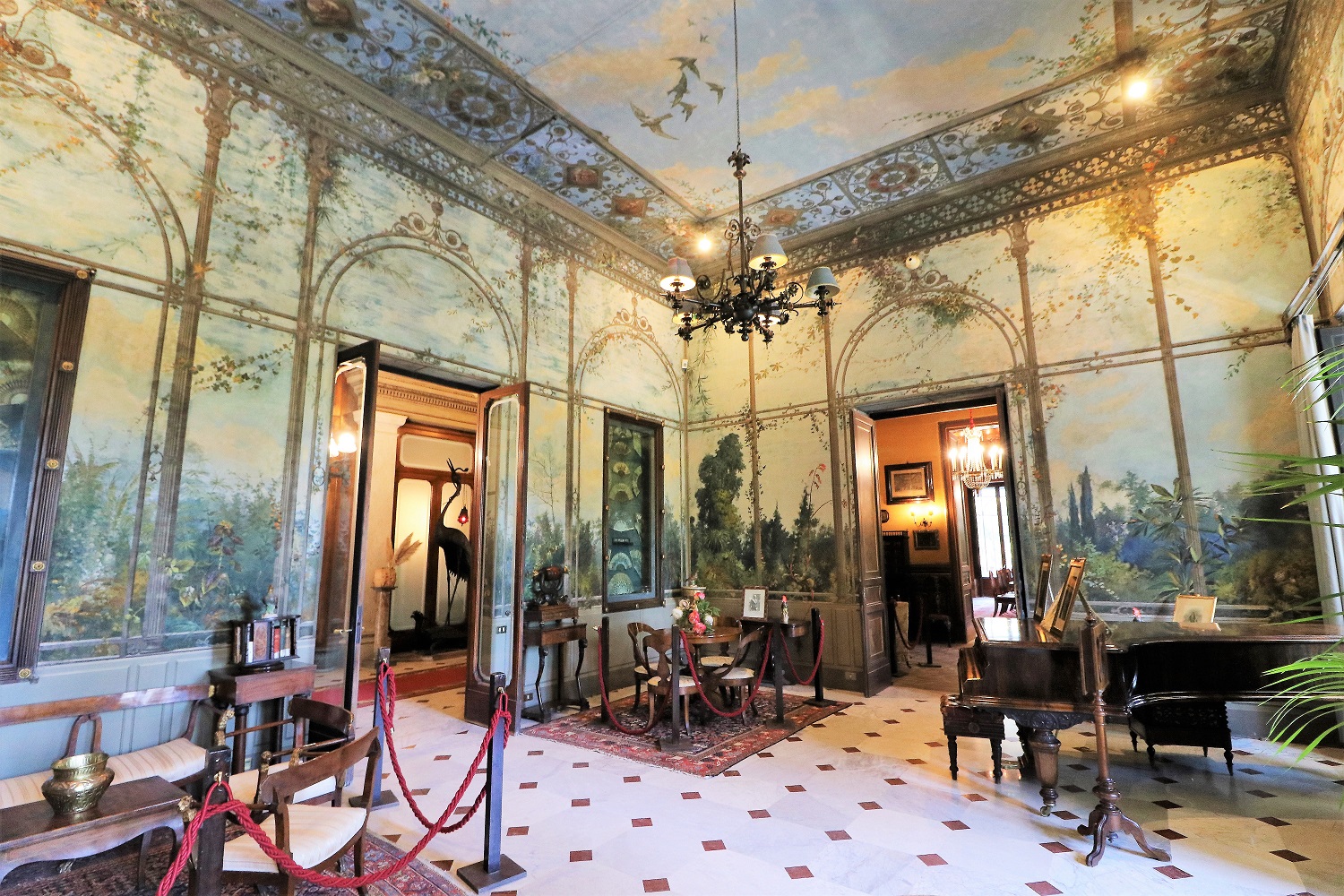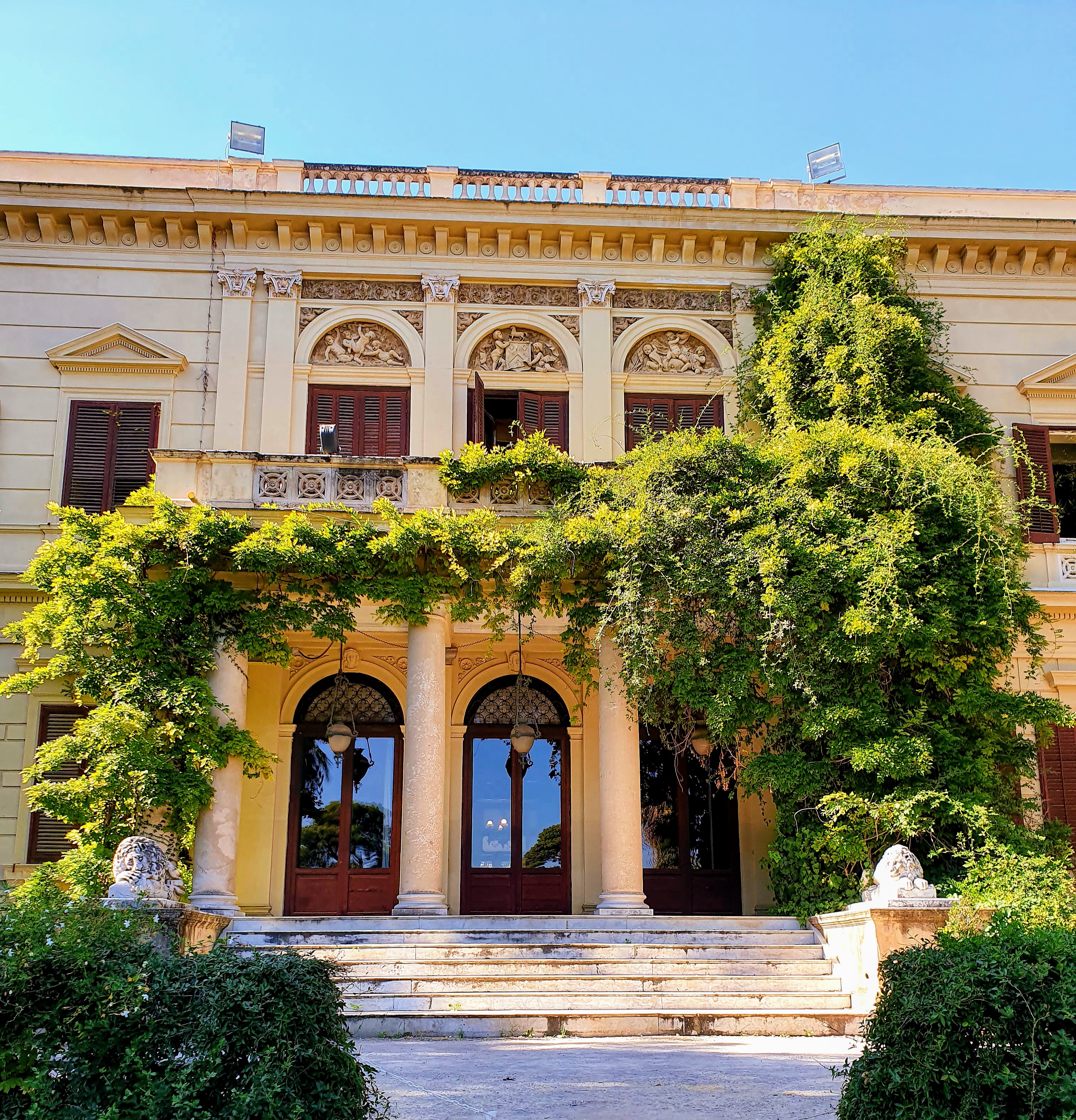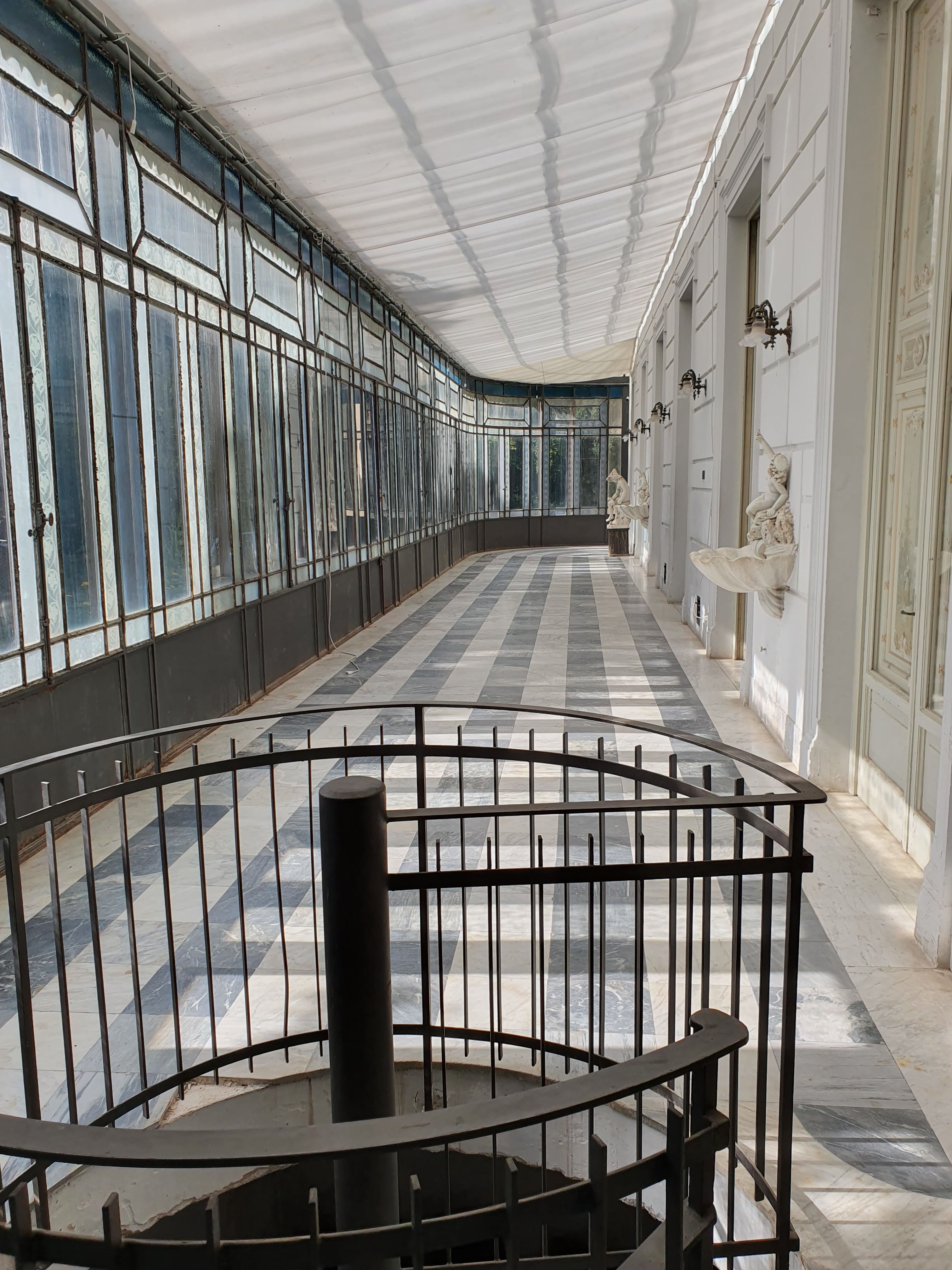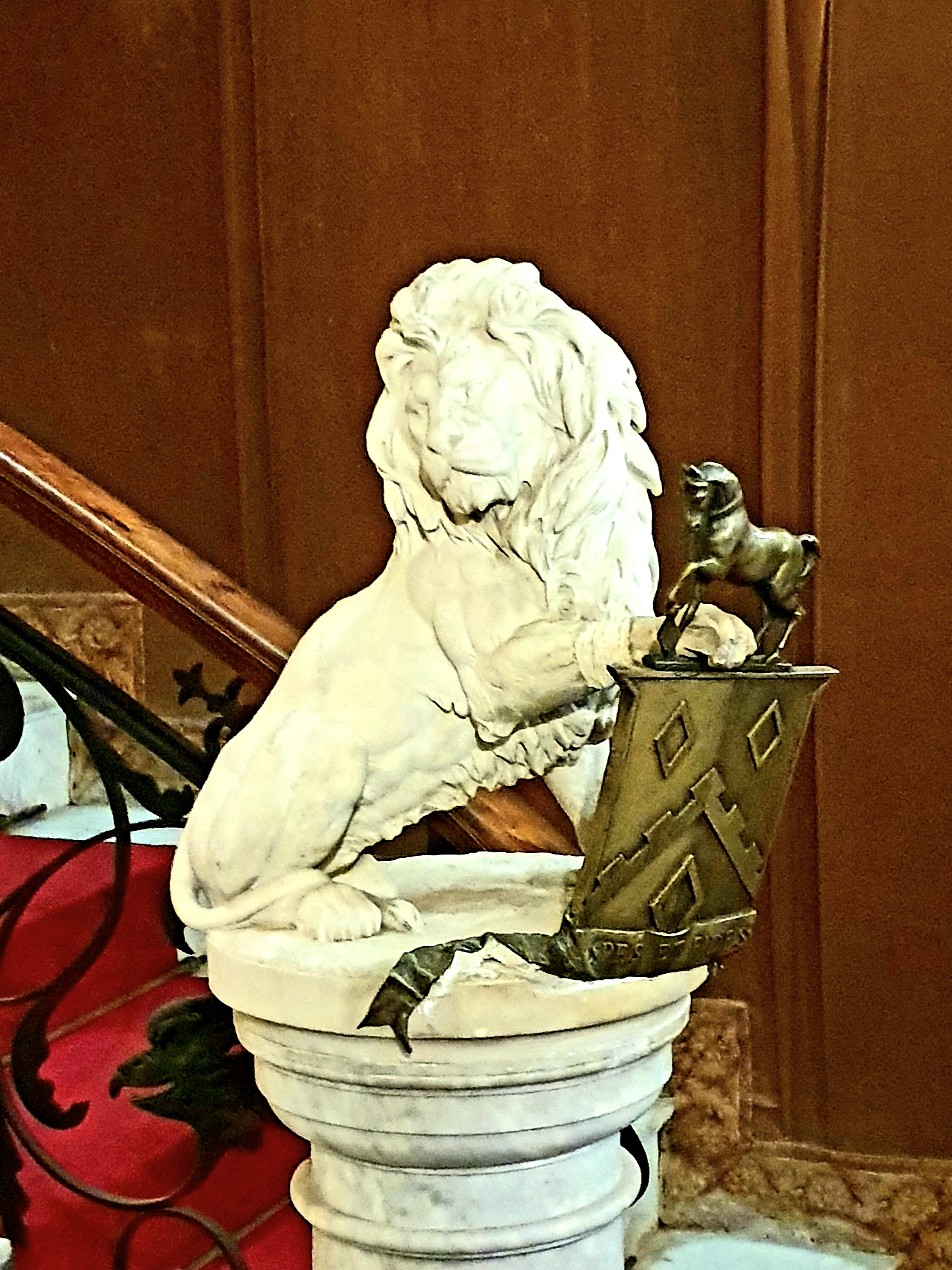
Read English version
Pip fu un appassionato archeologo e dopo avere acquistato l’isola di Mothya vi fece condurre i primi scavi; fu ornitologo e botanico e la sua interessante raccolta di uccelli impagliati è stata ceduta nel 1968 al museo di Belfort. Pip, grande appassionato di sport, fondò nel 1898 la società della Palermo-calcio Anglo Panormitan Foot-Ball club.
In questa dimora vissero le due figlie: Norina (1884-1895) che sposò il generale Antonino Di Giorgio, e Cordelia (Delia) (1885-1971) che ha istituito la Fondazione Joseph Whitaker.
Nel 1885 Joseph Whitaker comprò un vasto appezzamento di terreno nella contrada dei Lolli all’Olivuzza di proprietà del barone Beneventano. Il fondo Malfitano confinava con il fondo La farina e il fondo Marino Ajroldi.
L’arch. Ignazio Greco progettò la villa che venne edificata tra il 1885 ed il 1889 in stile neo-rinascimentale toscano ispirandosi, su richiesta di Tina, al villino Favard che si trova sul lungarno Amerigo Vespucci di Firenze.;
L’ingresso attuale si trova ad ovest e forma un esteso portico con colonne di ordine tuscanico che sostengono una terrazza al primo piano; quindi, si perviene al vestibolo decorato da due nicchie semicircolari e al vano d’ingresso ricco di alcuni prestigiosi arredi.
L’ingresso al giardino, un tempo quello principale, si trova sull’altro fronte.
Anch’esso è formato da un pronao-balcone, introdotto da una bianca gradinata e da due marmorei leoni scolpiti dal grande Mario Rutelli;

lungo i lati corti sono “l’orangerie”, lunga veranda giardino d’inverno con struttura in ghisa e vetri, realizzata su disegno di Ignazio Greco dalla fonderia Izambert di Parigi, e la veranda settentrionale.

La costruzione, a due piani, comprende al primo piano diverse camere da letto e studioli con importanti librerie alle pareti. Al piano terra si trovano gli ambienti di soggiorno e rappresentanza riccamente decorati e sfarzosamente arredati con mobili pregiati e suppellettili anche in avorio, corallo, argento… La galleria, lunga 36 metri, è stata dipinta dal pittore-decoratore Nicolini in stile pompeiano. Alle pareti si trovano importanti quadri di Francesco Lo Jacono.
Esposti ai lati della galleria si trovano due grandi elefanti cloisonnè, provenienti dal Palazzo d’Estate di Pechino, acquistati nel 1887 ad un’asta di Christie a Londra,
e due gru cinesi di bronzo, alte quasi due metri e mezzo poggianti su tartarughe e con lampade tunisine appese al becco. Pare che fossero simboli esoterici e che volessero simboleggiare i quattro elementi della terra.
I saloni comprendono: il salotto Luigi XV, la sala per la musica, la biblioteca e la sala da pranzo con ricchi arredi in legno (Ditta Ducrot), la sala del biliardo, il salotto d’estate dipinto, a finto gazebo pergolato, da Ettore De Maria Bergler e la sala da ballo- alle cui pareti si possono ammirare due dei cinque magnifici arazzi cinquecenteschi raffiguranti “le storie di Enea”. Tali arazzi provengono dal palazzo Colonna di Roma, ma sono stati commissionati per Palazzo Doria di Genova. Nella villa si trova un’importante raccolta di oggetti di antiquariato, oggetti esotici e dipinti dell’ottocento e del Novecento.
Una splendida scalinata porta al piano superiore; iniziando a salire, si può notare un leone con lo stemma dei Whitaker, opera della Ditta Ducrot.

Alle pareti della scala sono esposti gli altri tre arazzi cinquecenteschi con le storie di Enea. Il bellissimo e raffinato lucernario è di Salvatore Gregorietti.
Nella residenza erano stati installati i più moderni ritrovati tecnici dell’epoca: l’ascensore ed il riscaldamento.
Particolarmente apprezzabile è il parco, sistemato nel 1886 da Emilio Kunzmann (direttore della villa) ed Andrea Vizzini (capo giardiniere), secondo una disposizione all’inglese con viali liberi, boschetti, finte grotte, essenze esotiche e laghetti.
Prosperano in questo meraviglioso giardino esemplari di Yucca, Dracenia Drago e Sequoidendron giganteum ma tante sono le piante portate qui dai lunghi ed esotici viaggi dei Whitaker.
Dall’ingresso su via Dante, ornato da pregevole cancello in ferro battuto, si percorre un viale carrozzabile ovoidale che conduce al piazzale d’ingresso, dove si trova un busto di Giuseppe Whitaker del 1936. Nell’aiuola al centro del parco cresce un magnifico esemplare di Ficus Magnolioides messo a dimora nel 1888, la cui chioma ha raggiunto l’estensione di mille metri quadri. In passato alcune siepi del giardino venivano tagliate a “W2, per ricordare il cognome dei proprietari.
Intorno al 1900 venne impiantato un vivaio di orchidee esotiche provenienti da Villa Sofia, voliere con volatili esotici e daini.
Nel parco si trova anche una dependance, utilizzata come villino per il suocero, ed alcuni corpi di servizio. Oggi la dependance funziona come sede per mostre darte.
Foto copertina scaricata dal sito della fondazione Whitaker.
Indirizzo via Dante, 167, Telefono:0916820522 Per visite e orari si consiglia di visitare il sito web: www.villamalfitano.it/ opp www.fondazionewhitaker.it/
* ENGLISH
The sumptuous Villa Malfitano was the residence of Joseph Whitaker, Jr. known as Pip (Palermo 1850-1936), and Caterina (Tina) Scalia, daughter of General Alfonso Scalia.
Pip was a passionate archaeologist, so, after he had bought the island of Mothya he had the first excavations conducted there. He was also an ornithologist and botanist and his interesting collection of stuffed birds was ceded to the Belfort museum in 1968. Pip, a great sports fan, founded the Palermo-soccer company “Anglo Panormitan Foot-Ball Club” in 1898.
The two daughters lived in this house: Norina (1884-1895) who married General Antonino Di Giorgio, and Cordelia (Delia) (1885-1971) who bequeathed Mothya to the Joseph Whitaker Foundation, previously established by Delia herself.
In 1885 Joseph Whitaker bought a large piece of land in the Lolli district at Olivuzza, owned by Baron Beneventano. “Malfitano District” bordered on La Farina District and the Marino Ajroldi District.
The architect Ignazio Greco designed the villa which was built between 1885 and 1889 in a Tuscan Neo-Renaissance style since Tina Whitaker requested Greco to draw inspiration from the Villa Favard on the Lungarno Amerigo Vespucci in Florence.
The main entrance of the villa is to the west and forms an extensive portico with Tuscan-style columns supporting a terrace on the first floor; then you can access both the vestibule, which is decorated with two semicircular niches and the entrance hall that is rich in some prestigious furniture.
The entrance to the garden is on the other side and it is accessed by one of the halls. It is also characterized by a pronao-balcony, preceded by a white staircase and two marble lions sculpted by the great artist Mario Rutelli; along the short sides you can see “l’orangerie”, which is a long winter garden veranda with a structure made of cast iron and glass and which comes from the Izambert foundry in Paris, designed by Ignazio Greco, and the northern veranda.
The two-storey building with the piano cadetto ( the first one) and the basement includes several bedrooms and studios with elegant bookcases on the walls on the first floor. On the ground floor there are the living rooms and representation rooms, which are richly decorated and furnished with decorations and furniture including ivory, coral and silver. They are distributed throughout a gallery, thirty-six meters long, painted by the painter-decorator Nicolini, in the Pompeian style. In these rooms there is a strange and magical atmosphere characterized by precious furnishings ; there are two large cloisonné elephants, from the “Summer Palace” from the Imperial Palace in Peking, purchased in 1887 at the Christie’s auction in London, and two Chinese bronze cranes, almost two and a half meters high. Each crane rests on a turtle and has a Tunisian lamp hanging on the beak. Apparently they were esoteric symbols and symbolized the four elements of the earth.
The rooms include: the Louis XV drawing room, the music room, the library and the dining room with rich wooden furnishings (Ditta Ducrot), the billiard room, the ballroom and the painted summer room, which is a fake pergola gazebo by Ettore De Maria Bergler.
A splendid staircase leads to the upper floor; going up, you can see a lion with the Whitaker coat of arms, in carved wood, by the Ducrot Company.
In the residence the most modern technical discoveries of the time had been installed: the lift and indoor heating.
In addition to an important collection of antiques, exotic objects and paintings of the nineteenth and twentieth centuries, the villa houses five Gobelins tapestries, from the Colonna Palace in Rome, with “the scenes from the Story of Aeneas”, which are on the walls of the staircase.
Particularly noteworthy is the park, arranged in 1886 by Emilio Kunzmann (director of the villa) and Andrea Vizzini (head gardener), according to an English disposition with free avenues, small woods, fake caves, exotic essences and ponds.
In this wonderful garden, specimens of Yucca, Dracenia Drago and Sequoidendron giganteum thrive, there are also many plants brought by the Whitakers during their long and exotic trips .
From the entrance on via Dante, adorned with a fine wrought iron gate, you can walk along an ovoid carriage road that leads to the entrance square, where there has been a bust of Giuseppe Whitaker since 1936. In the flowerbed in the middle of the park grows a magnificent specimen of Ficus Magnolioides planted in 1888, whose crown has reached the extension of a thousand square metres. In the past some hedges of the garden were cut into a “W”, to recall the surname of the owners.
Around 1900 a nursery of exotic orchids from Villa Sofia was established along with aviaries with exotic birds and also some fallow deer.
In the park there is also an outbuilding, used as a villa for the father-in-law of the owner; and some service bodies were built. Today this annex is used as a venue for art exhibitions.
ADDRESS: via Dante, 167 Tel: 091 6820522 . For visits and timetable: websites: www.villamalfitano.it/ opp www.fondazionewhitaker.it/
